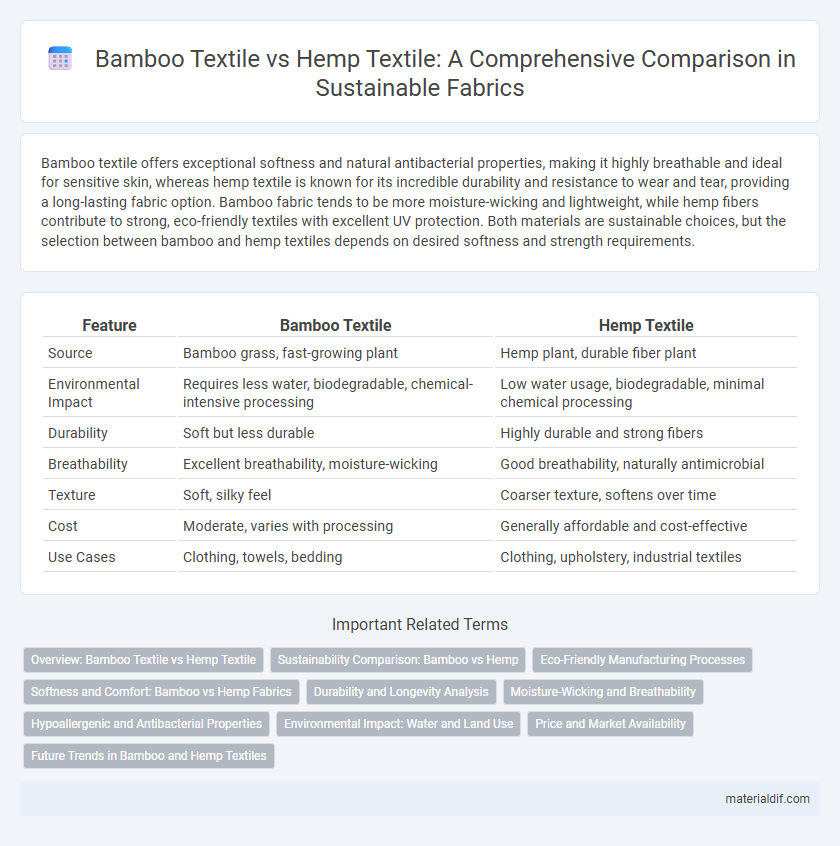Bamboo textile offers exceptional softness and natural antibacterial properties, making it highly breathable and ideal for sensitive skin, whereas hemp textile is known for its incredible durability and resistance to wear and tear, providing a long-lasting fabric option. Bamboo fabric tends to be more moisture-wicking and lightweight, while hemp fibers contribute to strong, eco-friendly textiles with excellent UV protection. Both materials are sustainable choices, but the selection between bamboo and hemp textiles depends on desired softness and strength requirements.
Table of Comparison
| Feature | Bamboo Textile | Hemp Textile |
|---|---|---|
| Source | Bamboo grass, fast-growing plant | Hemp plant, durable fiber plant |
| Environmental Impact | Requires less water, biodegradable, chemical-intensive processing | Low water usage, biodegradable, minimal chemical processing |
| Durability | Soft but less durable | Highly durable and strong fibers |
| Breathability | Excellent breathability, moisture-wicking | Good breathability, naturally antimicrobial |
| Texture | Soft, silky feel | Coarser texture, softens over time |
| Cost | Moderate, varies with processing | Generally affordable and cost-effective |
| Use Cases | Clothing, towels, bedding | Clothing, upholstery, industrial textiles |
Overview: Bamboo Textile vs Hemp Textile
Bamboo textile offers superior softness and moisture-wicking properties, making it ideal for comfortable clothing and activewear. Hemp textile provides exceptional durability and breathability, with strong resistance to UV light and mold, suited for eco-friendly and long-lasting fabrics. Both fibers are sustainable options, but bamboo grows faster with less water, while hemp enriches soil and requires fewer pesticides.
Sustainability Comparison: Bamboo vs Hemp
Bamboo textile production requires less water and grows faster than hemp, making it a highly renewable resource with a lower environmental footprint. However, hemp textiles offer superior durability and require minimal pesticides, supporting robust soil health and biodiversity. Both fibers contribute to sustainable fashion, but hemp's resilience and lower chemical input often position it as the more eco-friendly option overall.
Eco-Friendly Manufacturing Processes
Bamboo textile production uses a combination of mechanical and chemical processes that can be eco-friendly when utilizing closed-loop systems to recover chemicals and water, significantly reducing environmental impact. Hemp textile manufacturing primarily relies on mechanical processing, which requires less water and fewer chemicals, resulting in a lower ecological footprint compared to conventional fibers. Both fibers offer sustainable alternatives, but hemp's minimal chemical usage and higher yield per acre make it superior in eco-friendly manufacturing.
Softness and Comfort: Bamboo vs Hemp Fabrics
Bamboo textile is renowned for its exceptional softness and smooth texture, often compared to silk or cashmere, making it highly comfortable for direct skin contact. Hemp fabric, while durable and breathable, tends to have a coarser feel but softens significantly with repeated washing, improving comfort over time. The moisture-wicking and hypoallergenic properties of bamboo enhance its comfort level, whereas hemp's natural fibers provide excellent breathability and temperature regulation.
Durability and Longevity Analysis
Bamboo textiles exhibit high tensile strength and natural antibacterial properties, contributing to their durability in everyday use. Hemp textiles, known for exceptional resilience and resistance to wear, typically outlast bamboo fabrics due to their strong fibers and slower degradation rate. In comparative durability and longevity analysis, hemp textiles generally provide superior lifespan and sustained performance under repeated stress and washing.
Moisture-Wicking and Breathability
Bamboo textile exhibits superior moisture-wicking properties compared to hemp textile, efficiently drawing sweat away from the skin to keep the wearer dry and comfortable. Its naturally porous fiber structure enhances breathability, allowing better air circulation and faster drying times. While hemp is durable and breathable, bamboo's softness and moisture management make it a preferred choice for activewear and performance fabrics.
Hypoallergenic and Antibacterial Properties
Bamboo textile exhibits superior hypoallergenic properties due to its natural softness and minimal chemical processing, reducing skin irritation risks compared to hemp textile. Both bamboo and hemp possess inherent antibacterial qualities, but bamboo fabric contains bamboo kun, a natural bio-agent that enhances its ability to resist bacteria and odors more effectively than hemp. These attributes make bamboo textiles particularly suitable for sensitive skin and hygiene-focused applications.
Environmental Impact: Water and Land Use
Bamboo textile production requires significantly less water than hemp, with bamboo needing approximately 1,300 liters of water per kilogram compared to hemp's 4,000 liters. Land use for bamboo is also more efficient due to its rapid growth rate, yielding more fiber per hectare annually than hemp. Both crops are sustainable, but bamboo's minimal water footprint and faster regeneration contribute to a lower environmental impact in textile manufacturing.
Price and Market Availability
Bamboo textiles generally offer a lower price point compared to hemp textiles due to faster growth cycles and more established manufacturing processes. Hemp textiles, while often more expensive, are praised for their durability and environmental benefits but face limited market availability and fewer mass-production facilities. The global market shows increasing demand for both fibers, with bamboo dominating budget-friendly textile options and hemp positioned as a niche product for eco-conscious consumers.
Future Trends in Bamboo and Hemp Textiles
Bamboo and hemp textiles are gaining momentum due to their sustainable properties and eco-friendly production processes. Innovations in fiber processing and bio-based treatments are enhancing the softness and durability of bamboo and hemp fabrics, expanding their applications in fashion and home textiles. Market demand for biodegradable and renewable fibers is driving growth, positioning bamboo and hemp as key materials in the future of sustainable textile manufacturing.
Bamboo textile vs Hemp textile Infographic

 materialdif.com
materialdif.com